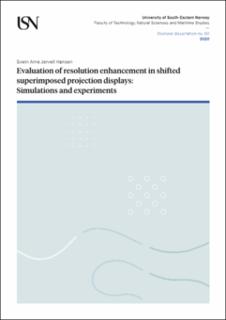| dc.contributor.author | Hansen, Svein Arne Jervell | |
| dc.date.accessioned | 2020-03-09T09:58:21Z | |
| dc.date.available | 2020-03-09T09:58:21Z | |
| dc.date.issued | 2020 | |
| dc.identifier.isbn | 978-82-7860-421-2 | |
| dc.identifier.issn | 2535-5252 | |
| dc.identifier.uri | https://hdl.handle.net/11250/2645962 | |
| dc.description.abstract | Spatial resolution is one of the key performance parameters of a projected display, and the projector industry continuously aims to increase it. Projector resolution is traditionally based on the resolution of the spatial light modulator (SLM), and increasing the projector resolution is typically done by increasing the SLM pixel count. However, increasing the amount of pixels on a single SLM is both cost intensive and technically challenging as not all SLM technologies support a sufficiently high pixel count. For this reason there has been a significant focus in recent years to develop resolution enhancing methods that allow projector resolution to exceed the native resolution of the projector SLM.
Shifted superimposition is one of the popular methods for increasing the resolution of the projected image. This is commonly done by shifting every other frame spatially on the projected screen with sub-pixel precision to form a new pixel grid with finer pixel pitch. Even though this is an established method, there are still an open question of how well this technique performs in comparison to native resolution, and how high the effective resolution gain really is.
In this PhD research we explore different aspects of resolution enhancement through shifted superimposition to gain more knowledge of how this method performs, and how to evaluate the actual resolution gain of this resolution enhancement method. We also review different ways the subframes may be generated, and what impact the shifting direction has on the resulting superimposed displayed image.
Through simulations and subjective observer experiments, we have established that the MSSSIM image quality metric is the most suitable metric to evaluate the simulated superimposed image since the results of this metric corresponds best with our subjective view of a good image. We have used this metric to evaluate different subframe generation techniques, and also as a tool to investigate the impact of the direction of the shift on the displayed image.
In this study we demonstrate the characteristics of the different categories of subframe generation methods, and that the subframe generation method used have a great impact on the overall quality of the superimposed image. Focusing on the shifting direction we establish that the quality of the superimposed image is almost invariant of the direction of the shift as long as the shift is not in horizontal or vertical direction.
The last part of this thesis explores the resolution gain of the shifted superimposition method, and examine the concept of resolution and quality in relation to each other. The research work involves simulations as well as measurements on a super-resolution projector. In this study we prove that the shifted superimposition method enhance the resolution approximately 40% above the native resolution given the desired source resolution | en_US |
| dc.language.iso | eng | en_US |
| dc.publisher | University of South-Eastern Norway | en_US |
| dc.relation.ispartofseries | Doctoral dissertations at the University of South-Eastern Norway;60 | |
| dc.relation.haspart | Article 1 Hansen, S.A.J., Akram, M.N., Hardeberg, J.Y. & Pedersen, M. (2018). Preferred image quality metric for shifted superimposition-based resolution-enhanced images, Journal of Electronic Imaging, 27(3), 1-13. doi:10.1117/1.JEI.27.3.033017 | en_US |
| dc.relation.haspart | Article 2 Byanju, R., Hansen, S.A.J. & Akram, M.N. (2018). A comparative study of superimposition techniques for enhancing the projector resolution: Simulations and experiments, Displays, 55, 80-89. doi:10.1016/j.displa.2018.11.002 | en_US |
| dc.relation.haspart | Article 3 Hansen, S.A.J., Akram, M.N. & Hardeberg, J.Y. (2019). Resolution enhancement through shifted superimposition: The influence of shift direction, Ready for submission. | en_US |
| dc.relation.haspart | Article 4 Hansen, S.A.J., Akram, M.N. & Hardeberg, J.Y. (2020). The effects of source resolution on resolution enhancement through shifted superimposition projection, Accepted for publication in "Journal of the Society for Information Display". | en_US |
| dc.relation.haspart | Article 5 Hansen, S.A.J, Akram, M.N. & Hardeberg, J.Y. (2017). Resolution enhancement through superimposition of projected images – How to evaluate the quality?, Electronic Imaging, 1, 141-146. doi:10.2352/ISSN.2470-1173.2017.12.IQSP-231 | en_US |
| dc.relation.haspart | Article 6 Hansen, S.A.J., Akram, M.N. & Hardeberg, J.Y. (2018). Pixel shifting in projected displays, Proceedings of the Image 2018 conference, 1, 62-67. | en_US |
| dc.relation.haspart | Article 7 Hansen, S.A.J., Akram, M.N. & Hardeberg, J.Y. (2019). Evaluation of Adaptive Shifted Superimposition Technique for Enhancing the Projector Resolution, Proceedings volume 11145 8th laser display and lightning conference (LDC 2019), doi:10.1117/12.2540345 | en_US |
| dc.subject | superimposition | en_US |
| dc.subject | display | en_US |
| dc.subject | projector | en_US |
| dc.subject | image processing | en_US |
| dc.title | Evaluation of resolution enhancement in shifted superimposed projection displays: Simulations and experiments | en_US |
| dc.type | Doctoral thesis | en_US |
| dc.rights.holder | Copyright the Author | en_US |
| dc.subject.nsi | VDP::Teknologi: 500 | en_US |
| dc.source.pagenumber | 146 | en_US |
